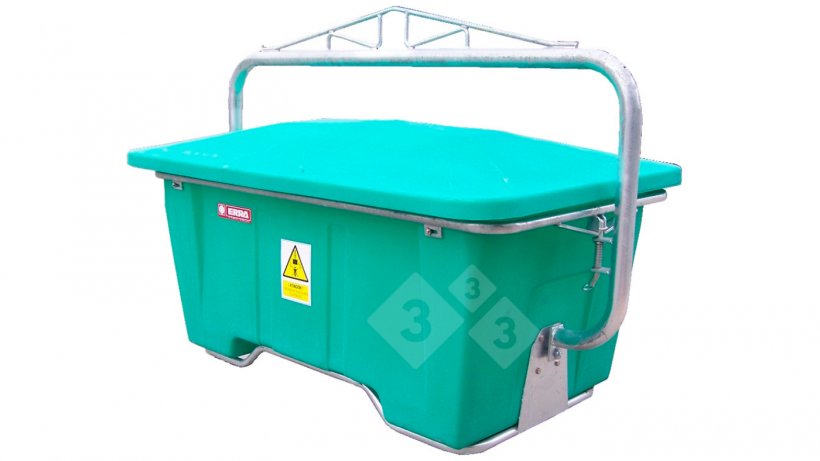Rendering
Rendering is a process that transforms animal carcasses or other by-products from food animal processing into water, fat, and protein.

The rendering works well to get rid of the everyday mortality on the farm and deals very well with increases in mortality (e.g. epidemics) if capacity is readily available. Refrigeration of carcasses can be applied when the rendering capacity is limited or exceeded by the number of dead animals. This allows the rendering plants to treat the carcasses when the capacity is resumed.
The rendering process is one of the carcass disposal methods with less impact on the environment due to the strict regulations that apply to the processing plants. Thus, rendering is one of the best environmental options to absorb both the everyday mortality or mass dead animals from swine farms if rendering plants are available in the area.
The movement of swine carcasses from farms to rendering plants is the main concern regarding biosecurity and disease transmission. However, there is a lack of information linking rendering with transmission of diseases and only risk assessments can be considered. Several actions such as mortality container placement or airtight rendering trucks can be taken to minimize this risk.
It is difficult to calculate the cost of rendering at the farm level as it may depend on the agreement between the farmer and the rendering company or the conditions under which the rendering is applied (e.g. number of trips to the farm, distance, volume). Estimated numbers from the U.S. swine market place the cost of rendering between that of composting and incineration, with incineration having the highest cost.
Rendering allows for traceability. Rendering trucks can weigh the carcasses and estimate the number of dead animals in each farm. Collecting that data provides an opportunity for a real-time and early warning system for syndromic surveillance that needs to be further explored.

Other available technologies
Other technologies different than the ones explained above can be found. The use of these alternative technologies and others not described here is usually less frequent.
Alkaline hydrolysis
Alkaline hydrolysis is a method that uses alkaline metal hydroxides for hydrolysis. The process converts biologic materials into an aqueous solution of amino acids, peptides, and sugars.
The environmental impact of this method is low. Carcasses are decomposed inside containers and the aqueous content may be released into the sanitary sewer system. Depending on the regulations, the hydrolysis containers and content have to be sent to a processing plant where the content is treated, and the containers are disinfected. Thus, effluent is not currently allowed to be discharged to sewers in the EU without prior treatment.
This method reduces the visits of external trucks to the farm. However, some truck visits may be needed to increase the number containers to adjust them with the farm mortality or to remove them. Current limitations of the alkaline hydrolysis are the need of an external truck to access the controlled area of the farm as well as the absence of ready-to-use containers to face a sudden increase in swine mortalities (e.g. catastrophic or epidemic situations).
Due to the scarcity of information it is difficult to find reliable data about the cost of hydrolysis in swine. However, the little information available seems to point that costs would be similar to or slightly higher than rendering.
Anaerobic digestion
Anaerobic digestion transforms and decomposes the organic matter in the absence of oxygen by using bacteria. Anaerobic digestion produces heat, CO2 and methane.
There is a lack of information on the environmental impact of this method when treating carcasses. Nevertheless, greenhouse gas emissions are a concern when treating manure using the anaerobic digestion and burning the methane to obtain energy.
The same implications regarding external truck visits explained previously can be applied here. The lack of anaerobic digestion plants and reference literature makes it difficult to be used under mass-mortalities.
The cost of this technology is usually high as it requires substantial investment in equipment to manage the anaerobic digestion.
Gasification
Gasification is a similar procedure to incineration as it reduces the carcasses into ashes. This method is more fuel efficient than incineration as it uses gases produced during the combustion of the biological materials to fuel further combustion.
Commercial adoption has been limited as the initial costs are high.
Homogenization
Producers homogenize carcasses of piglet mortalities by grounding them and disposing them into the existing manure system. Even though this process seems to have little impact on the increase of solid accumulation in waste storage structures, caution is needed in the spread of swine pathogens in the environment.
Conclusion
Several carcass disposal methods have been presented here. The decision to choose one or another should be subjected to different factors: presence of an adequate service, size of the farm, animal health and biosecurity, economic and environmental implications, and management of everyday or mass mortalities. One or more methods may be used in the presence of foreign animal diseases. In this case a good response plan involving governmental agencies, the private sector and the swine industry should be in place to avoid nuisances to the population, to reduce the environmental impact and protect the human and animal health.
Table 1. Summary of the main aspects of the different types of cadaver removal most used technologies (adapted from Gwyther et al., 2011. The environmental and biosecurity characteristics of livestock carcass disposal methods: A review. Waste Management, 31(4) pp. 767–778.).
| Method | Carcass management: |
Biosecurity aspects |
Environmental impact | |||||
|---|---|---|---|---|---|---|---|---|
| Pathogen contamination risk of: | ||||||||
| Process speed | Relative cost | Practicality (for the farmer) | Air (Bioaerosols) | Soil | Water | Contact with external trucks | ||
| Burial | Moderate | $ | Practical | Low | Moderate | Potential (MRN) | No | Potential soil contamination, odor |
| Composting | Slow | $$$ | Moderate | Medium | Moderate | MRN | No | Soil contamination if composting site not properly built |
| Burning | Fast | $$ | Moderate | MRN | MRN | MRN | No | Odor, dioxins, furans |
| Incineration (on farm) | Very fast | $$$$ | Moderate | Very low | Very low | Very low | No | Greenhouse emissions and air pollution with dioxins and furans if not properly maintained |
| Incineration (large central facility) | Very fast | $$$$ | Very practical | Very low | Very low | Very low | Yes | |
| Rendering | Very fast | $$$ | Very practical | Low (MRN) | N/A | MRN | Yes | Odor, potential water contamination if not treated |
| Alkaline hydrolysis | Fast | $$$ | Moderate | Very low | Very low | Very low | No (Yes if end product has to be removed to a treatment plant) | Odor if treatment on plant and potential water contamination if not treated |
| Anaerobic digestion | Slow | $$$$ | Moderate | Low | Moderate | Moderate | No | Not described but more research is needed |
MRN = More research is needed











